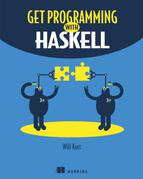Book Description
Summary
Get Programming with Haskell introduces you to the Haskell language without drowning you in academic jargon and heavy functional programming theory. By working through 43 easy-to-follow lessons, you'll learn Haskell the best possible way�by doing Haskell!
About the Technology
Programming languages often differ only around the edges�a few keywords, libraries, or platform choices. Haskell gives you an entirely new point of view. To the software pioneer Alan Kay, a change in perspective can be worth 80 IQ points and Haskellers agree on the dramatic bene ts of thinking the Haskell way�thinking functionally, with type safety, mathematical certainty, and more. In this hands-on book, that�s exactly what you�ll learn to do.
About the Book
Get Programming with Haskell leads you through short lessons, examples, and exercises designed to make Haskell your own. It has crystal-clear illustrations and guided practice. You will write and test dozens of interesting programs and dive into custom Haskell modules. You will gain a new perspective on programming plus the practical ability to use Haskell in the everyday world. (The 80 IQ points: not guaranteed.)
What�s inside
Thinking in Haskell
Functional programming basics
Programming in types
Real-world applications for Haskell
About the Reader
Written for readers who know one or more programming languages.
About the Author
Will Kurt currently works as a data scientist. He writes a blog at www.countbayesie.com, explaining data science to normal people.
